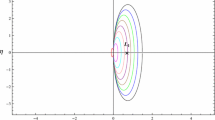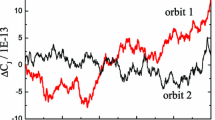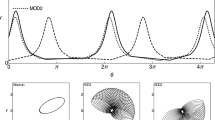Abstract
This work investigates the dynamics of the modified circular restricted three-body problem. The triaxial shape of the massive body, a modified gravitational parameter, quantum correction effect, radiation pressure and small perturbations in the Coriolis and centrifugal forces are all taken into account. The impact of the considered parameters in the equilibrium points and their linear stability is studied. Some new significant results in the critical mass parameter, \(\mu _c\), are observed in the presence of perturbing parameters. It is found that the critical mass parameter, \(\mu _c\), increases in the presence of modified gravitational potential, and it slightly decreases due to the quantum correction effect. Analytical construction of periodic orbits around the collinear equilibrium points is performed. Additionally, analysis of the impact of perturbations on the shape of these periodic orbits is conducted.







Similar content being viewed by others
Data availability
The study does not report any data.
References
Singh, J., Perdiou, A., Gyegwe, J.M., Perdios, E.: Periodic solutions around the collinear equilibrium points in the perturbed restricted three-body problem with triaxial and radiating primaries for binary HD 191408, Kruger 60 and HD 155876 systems. Appl. Math. Comput. 325, 358–374 (2018)
Abouelmagd, E.I., Alzahrani, F., Guirao, J., Hobiny, A.: Periodic orbits around the collinear libration points. J. Nonlinear Sci. Appl. (JNSA) 9(4), 1716–1727 (2016)
Patel, B.M., Pathak, N.M., Abouelmagd, E.I.: Stability analysis of first order resonant periodic orbit. Icarus 387, 115165 (2022)
Mahato, G., Kushvah, B.S., Pal, A.K., Verma, R.K.: Dynamics of the restricted three-body problem having elongated smaller primary with disc-like structure. Adv. Space Res. 69(9), 3490–3501 (2022)
Shalini, K., Idrisi, M.J., Singh, J., Ullah, M.S.: Stability analysis in the r3bp under the effect of heterogeneous spheroid. New Astron. 104, 102056 (2023)
McCuskey, S.W.: Introduction to Celestial Mechanics. Reading (1963)
Kishor, R., Kushvah, B.S.: Linear stability and resonances in the generalized photogravitational Chermnykh-like problem with a disc. Mon. Not. R. Astron. Soc. 436(2), 1741–1749 (2013)
Abouelmagd, E.I.: Stability of the triangular points under combined effects of radiation and oblateness in the restricted three-body problem. Earth Moon Planet. 110(3), 143–155 (2013)
Mia, R., Prasadu, B.R., Abouelmagd, E.I.: Analysis of stability of non-collinear equilibrium points: application to Sun–Mars and Proxima Centauri systems. Acta Astronautica
Douskos, C., Perdios, E.: On the stability of equilibrium points in the relativistic restricted three-body problem. Celest. Mech. Dyn. Astron. 82(4), 317–321 (2002)
Singh, J., Ishwar, B.: Stability of triangular points in the generalised photogravitational restricted three body problem (1999)
Yousuf, S., Kishor, R.: Effects of the albedo and disc on the zero velocity curves and linear stability of equilibrium points in the generalized restricted three-body problem. Mon. Not. R. Astron. Soc. 488(2), 1894–1907 (2019)
Verma, R.K., Kushvah, B.S., Mahato, G., Pal, A.K.: Perturbed restricted problem of three bodies with elongated smaller primary. J. Astronaut. Sci. 70(3), 1–26 (2023)
Ishwar, B., Elipe, A.: Secular solutions at triangular equilibrium point in the generalized photogravitational restricted three body problem. Astrophys. Space Sci. 277(3), 437–446 (2001)
Singh, J., Leke, O.: Stability of the photogravitational restricted three-body problem with variable masses. Astrophys. Space Sci. 326, 305–314 (2010)
Ershkov, S., Leshchenko, D., Abouelmagd, E.I.: About influence of differential rotation in convection zone of gaseous or fluid giant planet (Uranus) onto the parameters of orbits of satellites. Eur. Phys. J. Plus 136(4), 1–9 (2021)
Murray, C.D., Dermott, S.F.: Solar System Dynamics. Cambridge University Press, Cambridge (1999)
Abouelmagd, E.I., Alhothuali, M., Guirao, J.L., Malaikah, H.: The effect of zonal harmonic coefficients in the framework of the restricted three-body problem. Adv. Space Res. 55(6), 1660–1672 (2015)
Verma, R.K., Pal, A.K., Kushvah, B.S., Mahato, G.: Effect of finite straight segment and oblateness in the restricted 2+2 body problem. Arch Appl Mech 1–17 (2023)
Ceccaroni, M., Celletti, A., Pucacco, G.: Birth of periodic and artificial halo orbits in the restricted three-body problem. Int. J. Non-Linear Mech. 81, 65–74 (2016)
Gao, F., Wang, Y.: Approximate analytical periodic solutions to the restricted three-body problem with perturbation, oblateness, radiation and varying mass. Universe 6(8), 110 (2020)
Elshaboury, S., Abouelmagd, E.I., Kalantonis, V., Perdios, E.: The planar restricted three-body problem when both primaries are triaxial rigid bodies: equilibrium points and periodic orbits. Astrophys. Space Sci. 361(9), 1–18 (2016)
Jain, S., Kumar, A., Bhatnagar, K.: Periodic orbits around the collinear liberation points in the restricted three body problem when the smaller primary is a triaxial rigid body: Sun-earth case. Bull. Astron. Soc. India 34, 211 (2006)
Jain, S., Kumar, A., Bhatnagar, K.: Periodic orbits around the collinear libration points in the restricted three body problem when the smaller primary is a triaxial rigid body and bigger primary is a source of radiation pressure. Indian J. Phys. 83(2), 171–184 (2009)
Hod, S.: A simplified two-body problem in general relativity. Int. J. Mod. Phys. D 22(12), 1342029 (2013)
Larrouturou, F.: Analytical methods for the study of the two-body problem, and alternative theories of gravitation. Ph.D. Thesis, Sorbone Université (2021)
Benisty, D.: Testing modified gravity via Yukawa potential in two body problem: analytical solution and observational constraints. Phys. Rev. D 106(4), 043001 (2022)
Zotos, E.E., Chen, W., Abouelmagd, E.I., Han, H.: Basins of convergence of equilibrium points in the restricted three-body problem with modified gravitational potential. Chaos Solit. Fractals 134, 109704 (2020)
De, S., Roychowdhury, S., Banerjee, R.: Beyond-Newtonian dynamics of a planar circular restricted three-body problem with Kerr-like primaries. Mon. Not. R. Astron. Soc. 501(1), 713–729 (2021)
Abouelmagd, E.I., Ansari, A.A., Shehata, M.: On Robe’s restricted problem with a modified Newtonian potential. Int. J. Geom. Methods Mod. Phys. 18(01), 2150005 (2021)
Battista, E., Esposito, G.: Restricted three-body problem in effective-field-theory models of gravity. Phys. Rev. D 89(8), 084030 (2014)
Battista, E., Dell’Agnello, S., Esposito, G., Simo, J.: Quantum effects on Lagrangian points and displaced periodic orbits in the earth–moon system. Phys. Rev. D 91(8), 084041 (2015)
Alshaery, A., Abouelmagd, E.I.: Analysis of the spatial quantized three-body problem. Results Phys. 17, 103067 (2020)
Abouelmagd, E.I., Kalantonis, V.S., Perdiou, A.E.: A quantized Hill’s dynamical system. Adv. Astron. (2021)
Bjerrum-Bohr, N.E.J., Donoghue, J.F., Holstein, B.R.: Quantum gravitational corrections to the nonrelativistic scattering potential of two masses. Phys. Rev. D 67(8), 084033 (2003)
Donoghue, J.F.: Leading quantum correction to the Newtonian potential. Phys. Rev. Lett. 72(19), 2996 (1994)
Katour, D., El-Salam, A., Shaker, M., et al.: Relativistic restricted three body problem with oblatness and photo-gravitational corrections to triangular equilibrium points. Astrophys. Space Sci. 351(1), 143–149 (2014)
Subbarao, P., Sharma, R.K.: A note on the stability of the triangular points of equilibrium in the restricted three-body problem. Astron. Astrophys. 43, 381–383 (1975)
Acknowledgements
The first and second authors are thankful to the Department of Mathematics and Computing Indian Institute of Technology (Indian School of Mines)—Dhanbad, for providing facilities to prepare this manuscript. The third author is supported by Enhanced Seed Grant through Endowment Fund Ref: EF/2021-22/QE04-07 from Manipal University Jaipur.
Author information
Authors and Affiliations
Contributions
The research in this study was equally contributed by all of the authors.
Corresponding author
Ethics declarations
Conflict of interest
The authors have no relevant financial or non-financial interests to disclose.
Additional information
Publisher's Note
Springer Nature remains neutral with regard to jurisdictional claims in published maps and institutional affiliations.
Appendices
Appendix
Appendix A: Terms used in non-collinear equilibrium points \((\theta _{1,2})\)
Appendix B: Terms used for the partial derivatives of \(\Omega \)
Rights and permissions
Springer Nature or its licensor (e.g. a society or other partner) holds exclusive rights to this article under a publishing agreement with the author(s) or other rightsholder(s); author self-archiving of the accepted manuscript version of this article is solely governed by the terms of such publishing agreement and applicable law.
About this article
Cite this article
Verma, R.K., Kushvah, B.S. & Pal, A.K. Dynamics of the perturbed restricted three-body problem with quantum correction and modified gravitational potential. Arch Appl Mech 94, 651–665 (2024). https://doi.org/10.1007/s00419-024-02543-3
Received:
Accepted:
Published:
Issue Date:
DOI: https://doi.org/10.1007/s00419-024-02543-3




